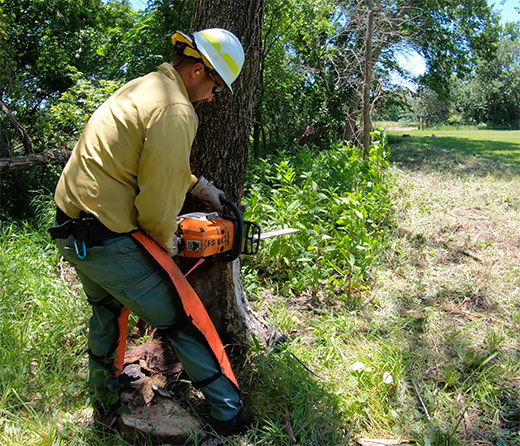
A Kansas Forest Service official recommends wearing a hard hat and chaps anytime you're using a chainsaw. | Download this photo.
Think safety first when operating chainsaw, says forest official
Chaps, hard hat are among safety equipment
Oct. 23, 2020
MANHATTAN, Kan. – A Kansas Forest Service official advises homeowners and landowners to exercise caution when using chainsaws for fall timber projects or gathering firewood for winter.
“First, anyone operating a chainsaw, like any powerful equipment, needs to be sure they are familiar with the specific model they operate, including safety features and suggestions in the owners’ manual for safe operation,” said Eric Ward, assistant fire management officer.
According to the U.S. Centers for Disease Control and Prevention, 36,000 people suffer chainsaw injuries requiring hospital treatment each year.
“At the speed chainsaws run, something as simple as kick-back from the tip of the bar striking an object can occur too quickly for even the quickest individual to evade,” Ward said.
Ward suggests a few safety tips to keep in mind:
- Chainsaws should be started with the chain brake engaged, either on the ground or with a firm grasp.
- The thumb of the hand holding the saw should always be wrapped fully around the handle to reduce the chance of kick-back occurring.
- Always wear eye and ear protection.
- Always wear sturdy boots, long pants, and long sleeves to protect against limbs and debris that may be thrown by the saw. Do not wear loose or baggy clothing that could get caught up in equipment or limbs.
Ward encourages wearing chaps and a hard hat when operating a chainsaw.
Chaps are made with multiple layers of loosely woven Kevlar or similar material, that cover the lower legs. The Kevlar offers limited cut protection, but more importantly, an accidental strike to the chaps will pull out wads of Kevlar fibers that will stop the chainsaw before it has time to cause serious injury. Many potentially life-threatening injuries have been prevented by chaps, Ward said.
A hard hat protects against flying limbs or debris and offers limited protection in case of a violent kick-back of the saw bar towards the head.
When operating the saw, Ward advises:
- Make sure no one is within reach of the tip of the saw bar when cutting.
- Always know where the tip of the bar is, as a common cause of kickback is when the tip is hidden behind the object being cut, and strikes another object, throwing it up and backward violently.
- Estimate where the tree or limb you are cutting is going to fall, and if felling a tree, make sure no one, and nothing of value (such as a vehicle) is within a distance twice the height of the tree.
“Chainsaws are valuable tools, and save a huge amount of physical labor,” Ward said. “They also have real potential to cause harm. Following these basic chainsaw safety practices will help keep your saw work safe and efficient.”
More information is available online in a publication from the Kansas Forest Service.

